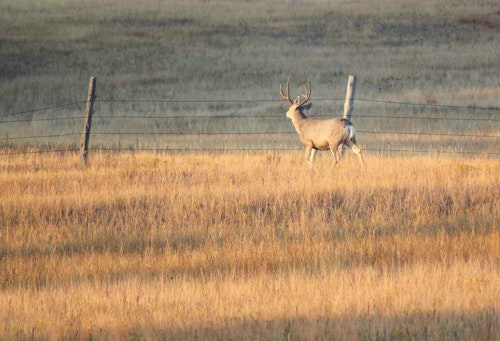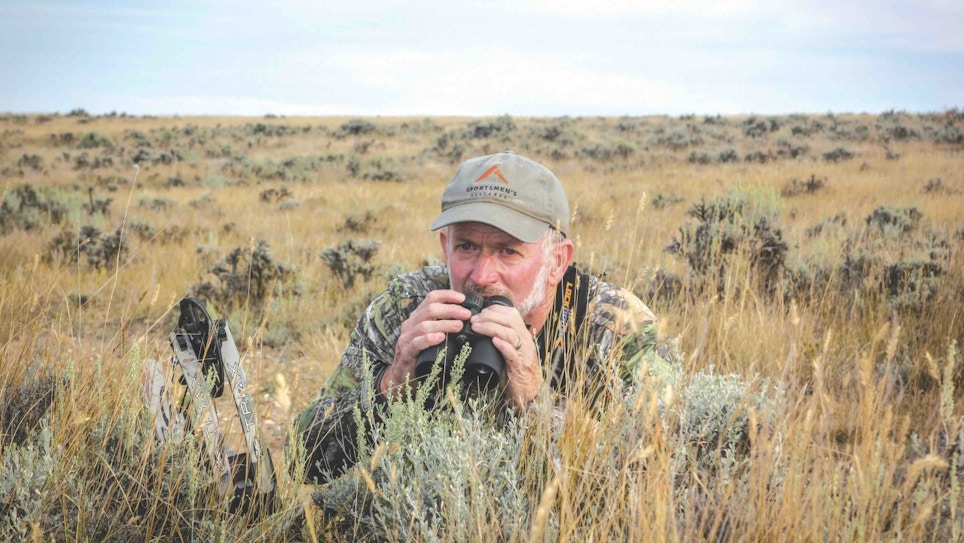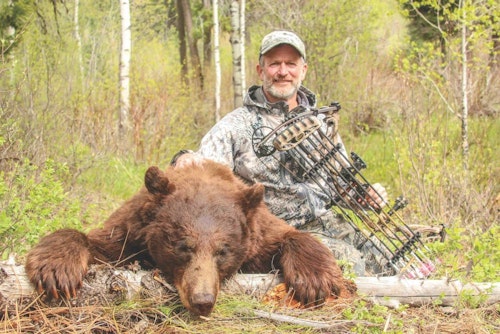In North America, the vast majority of bowhunters sit in a ground blind or utilize a treestand. That’s because most are whitetail hunters, and this is really the best way to bowhunt them, almost always. Of the 29 recognized species of big game in North America, truthfully, only whitetails (including the Coues subspecies), black bears and pronghorn are vulnerable to stand hunting most of the time. All the others — including some that are bowhunted from a stand at times, including elk and mule deer — are so unpredictable that the spot-and-stalk bowhunter has better odds. That is, if you know what you’re doing.
Spot-and-stalk bowhunting raises the bar when it comes to the challenge. It’s like chess — without the confinement of the board — where you have to assess many variables at once, stay flexible, know when to go hard and when to go slow, when to attack and when to retreat. This isn’t a treatise on locating game to stalk. Let’s assume you know how to do that. Here, then, are 11 things the successful spot-and-stalk bowhunter must do, both prior to, and during, the hunt.
1) Practice Shooting
Spot-and-stalk hunting means you must be able shoot from your knees and/or your butt, and you’re going to have to be able to shoot at distances much further than you would when whitetail hunting from ambush. You’ll need to shoot with your torso twisted at odds angles, and at steep uphill and downhill angles. You’ll also need to understand your arrow trajectory completely, so you can lob one over any brush between you and the animal, as well as through small holes in the surrounding cover. If there is a roving 3-D course close to home, wear out those targets.
2) Silence Your Gear
You must check your bow, quiver, backpack and any other gear to ensure nothing will make any noise during your stalk. That might mean tightening screws or taping zippers, for example. Your clothing must be made of soft, silent fabrics, and your stalking boots must be soft-soled. Try it all out at home first and solve problems before the hunt.
3) Know the Distance
Shooting at extended distances means you must know the yardage exactly, and that means employing a laser rangefinder. It also means having it where you can get at it quickly and quietly, use it, and then get rid of it so you can make the shot. Some binocular harnesses have rangefinder pouches that keep it near your chest. I tie a long cord to mine and loop it over my neck and under my right armpit. It hangs belt high when I’m stalking (my cord is just long enough the rangefinder sits out of the way inside my pants pocket); after I take a reading, I can simply let it drop out of the way.
4) Assess the Situation
Take in the whole world the moment you have found your animal. How will you keep the sun at your back and wind in your face? What terrain features — draws, creek bottoms, timber stringers, brush, etc. — will cover your approach? Is there another animal (or several others), making the approach to the target problematic? Never become so fixated on your target animal that you forget about any other nearby animals. As often as not, these are the animals that will blow the stalk for you. Pinpoint their location before you leave, and be constantly on the lookout for them as you make your approach.
5) Monitor the Wind
Nothing will ruin a stalk faster than the wrong wind. I often won’t even attempt a stalk on a calm day, or a day when the wind is swirling, because a swirling wind will send my stink to the animal eventually. On the other hand, a constant, consistent wind helps mask any noise you might make during your approach. You should test the wind direction and speed frequently, paying close attention to currents and thermals; if the wind changes, be ready to make a 180-degree turn. Always keep the wind in your face or stay at a crosswind to the target animal.
6) Keep Cool
By nature, I’m an aggressive bowhunter. Once I spot an animal I want, my gut reaction is to rush over there and shoot it — right now! But I’ve learned it is important to stay under control and be patient, making your move only when the time is right.
For example, when I see a mule deer buck go lay down, rather than rush over to attempt a shot, I’ll wait 45 minutes to an hour and watch him. Often bucks will bed for an hour or so, then get up and move a short distance before bedding again. Usually when they do this, they’re bedded for hours, making stalking so much easier. Waiting a bit also permits me to carefully scrutinize the country, looking for other deer and defining my stalking route. I call my method “controlled aggression.”
7) Take an Angle
Making a stalk is all about angle management. By that I mean once you’ve spotted an animal you want, you then carefully study the land contours, using them to plan an approach that keeps the maximum amount of cover between you and the animal while keeping the wind right. It might mean some belly-crawling. It also means you’ll lose sight of the animal, so you have to pick a terrain feature as your target and head for it. When you get there, you may not be able to close the distance sufficiently to make the shot. The animal may have moved off. Lots can go wrong — and often will. You just have to try and see what happens.
8) Stay Back
It’s important to assess the lay of the land, the number of other animals present and other factors that seriously reduce your chances to sneak within bow range. There are just some situations where the odds just are not with you. If the stalk looks bleak, it’s the time to wait; instead, keep your eyes on your target and don’t move in until conditions are favorable. Unless it’s the last day, that might be tomorrow.

9) Relocate Game
The whole idea behind spot-and-stalk hunting is to spot an animal you want, then move in undetected for a shot. To that end, there are some things you must do as you get close without spooking anything. Most important is relocating the animal after you’ve lost sight of it during your approach, especially if it’s bedded in or near thick cover. This is the make-or-break point in most stalks. The key is to relocate the animal without being detected. To do so, use your bino meticulously to find the animal again. This is true even when the distance between you is relatively short. You’re not necessarily looking for the whole animal, but just a piece of it — an antler tine, black nose, eye, flicking ear or horizontal backline in a vertical sea of tree trunks. Sometimes a twitching tail is the giveaway. Be patient. Just because you don’t see it right off the bat, doesn’t mean it’s not right there. Sure, your quarry might have gotten up and fed off a ways, but unless panicked, it’ll be close by. My rule of thumb when stalking any animal is simply this: If I have not seen it run off with my own eyes, it’s still there. So I keep looking.
10) Be Patient
At the end of the stalk, with your heart beating its way out of your chest and your palms so sweaty it’s hard to grip your bow, slow down! I have a saying: “Why am I in such a hurry to blow this stalk?” Don’t hurry, unnecessarily. This point cannot be overemphasized. As sure as the sun rises in the East, you’ll ruin most stalks by moving too fast, by becoming impatient, and by letting your adrenaline overcome commonsense. That’s not to say there are not times when you have to move quickly — run even — but those moments generally occur long before the final stalk. But at the end of the day, I’ve ruined more stalks by moving too quickly and carelessly than by taking extra time to carefully place each step, slowly weave in and out of brush and keeping my breathing under control.
11) Make the Shot
It’s time. You’ve pulled it off and there he is, well within your MESR (Maximum Effective Shooting Distance), the wind is right and all is well. Of course, you want to shoot him right now before he gets away, right? That’s a formula for missing. Get your breathing under control. Unless he’s in your face, take a rangefinder reading. Go through your mental shot checklist. Mine is, pick a small spot on the animal’s chest I want to hit, nock the arrow properly, draw, anchor snugly, nose on the string and peep aligned with the sight, pick the proper pin, control my breathing, release. Now cut the shot, just like you did a thousand times on the practice range.
When the arrow hits its mark, don’t panic. Of course, you’re out-of-your-mind excited, because you just executed the most difficult of all bowhunting challenges — stalking into range of a big game animal and made the shot! It’s not a TV show where you have to high-five a cameraman, so sit still and be quiet. Listen for the sound of the animal running off, and hopefully crashing to the ground. After a bit, when the shaking has stopped, go to the exact spot where the animal was when you made the shot; look for blood and your arrow. Assess, and then go get it based on the blood your find.
Trust me on this one: When you find the downed animal, the feeling of accomplishment and satisfaction will be like no other you’ve ever experienced as a bowhunter.

Sidebar: BREATHE!
In preparation of making the shot, or to recover from a brief burst of exertion, use deep diaphragmatic breathing to regain your composure. This method is a powerful tool to control hyperventilation, slow your heartbeat and remove anxiety, AKA “buck-fever.”
At the moment-of-truth, remember these steps:
- Through your nose, take a long, slow breath ensuring you are filling your lower lungs first, and then your upper lungs.
- Hold the breath for 3 seconds.
- Exhale slowly through your mouth while relaxing the muscles in your face, neck, shoulders and then the entire body.
- Repeat three to five times or until time has run out.
- Draw and shoot!








